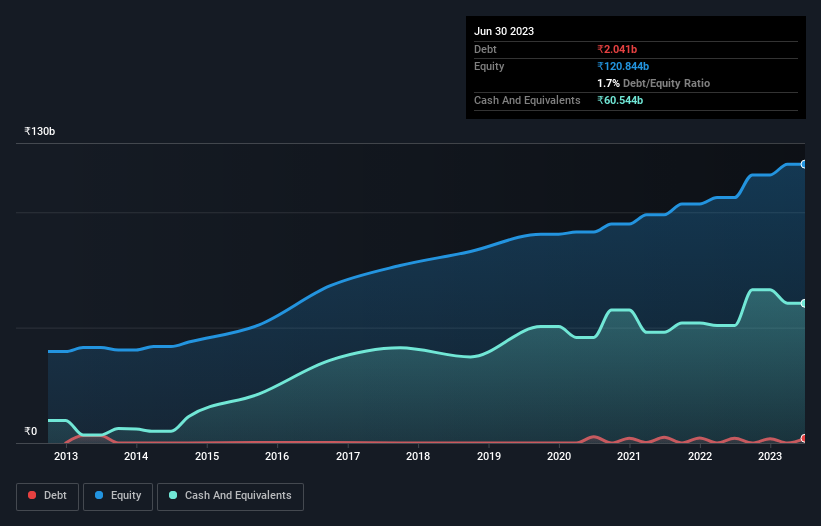
Howard Marks put it nicely when he said that, rather than worrying about share price volatility, 'The possibility of permanent loss is the risk I worry about... and every practical investor I know worries about.' When we think about how risky a company is, we always like to look at its use of debt, since debt overload can lead to ruin. As with many other companies Siemens Limited (NSE:SIEMENS) makes use of debt. But the real question is whether this debt is making the company risky.
When Is Debt A Problem?
Debt is a tool to help businesses grow, but if a business is incapable of paying off its lenders, then it exists at their mercy. Ultimately, if the company can't fulfill its legal obligations to repay debt, shareholders could walk away with nothing. However, a more frequent (but still costly) occurrence is where a company must issue shares at bargain-basement prices, permanently diluting shareholders, just to shore up its balance sheet. By replacing dilution, though, debt can be an extremely good tool for businesses that need capital to invest in growth at high rates of return. When we think about a company's use of debt, we first look at cash and debt together.
View our latest analysis for Siemens
What Is Siemens's Debt?
The chart below, which you can click on for greater detail, shows that Siemens had ₹2.04b in debt in March 2023; about the same as the year before. However, its balance sheet shows it holds ₹60.5b in cash, so it actually has ₹58.5b net cash.

How Healthy Is Siemens' Balance Sheet?
The latest balance sheet data shows that Siemens had liabilities of ₹79.2b due within a year, and liabilities of ₹6.10b falling due after that. Offsetting this, it had ₹60.5b in cash and ₹62.1b in receivables that were due within 12 months. So it actually has ₹37.4b more liquid assets than total liabilities.
This surplus suggests that Siemens has a conservative balance sheet, and could probably eliminate its debt without much difficulty. Succinctly put, Siemens boasts net cash, so it's fair to say it does not have a heavy debt load!
In addition to that, we're happy to report that Siemens has boosted its EBIT by 49%, thus reducing the spectre of future debt repayments. The balance sheet is clearly the area to focus on when you are analysing debt. But ultimately the future profitability of the business will decide if Siemens can strengthen its balance sheet over time. So if you want to see what the professionals think, you might find this free report on analyst profit forecasts to be interesting.
Finally, a company can only pay off debt with cold hard cash, not accounting profits. While Siemens has net cash on its balance sheet, it's still worth taking a look at its ability to convert earnings before interest and tax (EBIT) to free cash flow, to help us understand how quickly it is building (or eroding) that cash balance. During the last three years, Siemens produced sturdy free cash flow equating to 60% of its EBIT, about what we'd expect. This free cash flow puts the company in a good position to pay down debt, when appropriate.
Summing Up
While we empathize with investors who find debt concerning, you should keep in mind that Siemens has net cash of ₹58.5b, as well as more liquid assets than liabilities. And it impressed us with its EBIT growth of 49% over the last year. So we don't think Siemens's use of debt is risky. Over time, share prices tend to follow earnings per share, so if you're interested in Siemens, you may well want to click here to check an interactive graph of its earnings per share history.
At the end of the day, it's often better to focus on companies that are free from net debt. You can access our special list of such companies (all with a track record of profit growth). It's free.
If you're looking to trade Siemens, open an account with the lowest-cost platform trusted by professionals, Interactive Brokers.
With clients in over 200 countries and territories, and access to 160 markets, IBKR lets you trade stocks, options, futures, forex, bonds and funds from a single integrated account.
Enjoy no hidden fees, no account minimums, and FX conversion rates as low as 0.03%, far better than what most brokers offer.
Sponsored ContentNew: Manage All Your Stock Portfolios in One Place
We've created the ultimate portfolio companion for stock investors, and it's free.
• Connect an unlimited number of Portfolios and see your total in one currency
• Be alerted to new Warning Signs or Risks via email or mobile
• Track the Fair Value of your stocks
Have feedback on this article? Concerned about the content? Get in touch with us directly. Alternatively, email editorial-team (at) simplywallst.com.
This article by Simply Wall St is general in nature. We provide commentary based on historical data and analyst forecasts only using an unbiased methodology and our articles are not intended to be financial advice. It does not constitute a recommendation to buy or sell any stock, and does not take account of your objectives, or your financial situation. We aim to bring you long-term focused analysis driven by fundamental data. Note that our analysis may not factor in the latest price-sensitive company announcements or qualitative material. Simply Wall St has no position in any stocks mentioned.
About NSEI:SIEMENS
Siemens
Manufactures and sells electric motors, generators, transformers, electricity distribution and control apparatus, general purpose machinery, other electrical equipment, electronic components, and optical products in India and internationally.
Solid track record with excellent balance sheet and pays a dividend.


